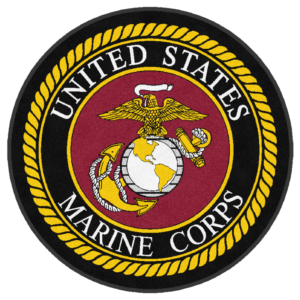 The Marine Corps defines one tattoo as one (1) or multiple tattoos spaced apart that can still be covered by a circle with the diameter of five (5) inches – multiple tattoos spaced further apart that cannot be covered within that criteria are considered separate tattoos.
The Marine Corps defines one tattoo as one (1) or multiple tattoos spaced apart that can still be covered by a circle with the diameter of five (5) inches – multiple tattoos spaced further apart that cannot be covered within that criteria are considered separate tattoos.
Content
Tattoos or brands that are prejudicial to good order, discipline, and morale, or are of a nature to bring discredit upon the Marine Corps are prohibited. “Prejudicial to good order, discipline, and morale or are of a nature to bring discredit to the Marine Corps” may include, but are not limited to, any tattoo that is sexist (express nudity), racist, eccentric (departing from the established or traditional norm) or offensive in nature, vulgar, express an association with conduct or substances prohibited by Marine Corps Drug Policy and the UCMJ (illegal drugs / drug use / paraphernalia), anti-American, anti-social, gang related, or extremist group or organization related.
Tattoos that are not visible or apparent without the use of ultra-violet lighting (black light) must meet policy standards.
Location
Tattoos or brands on the head and neck, hands, fingers, wrists or in the mouth are prohibited. The area of the neck is defined as any portion above the collarbone in the front area, above the first cervical vertebrae in the back area, or otherwise visible due to the open collar of the short sleeve khaki shirt, without an undershirt.
Tattoos / brands will not be visible or apparent on the feet or legs when wearing the service a, blue dress a/b, blue-white dress a/b, or the evening dress uniforms
Size
Sleeve tattoos (a very large tattoo, or a collection of smaller tattoos, that covers or almost covers a person’s entire arm or leg) are prohibited Half-sleeve or quarter-sleeve tattoos (very large tattoo, or a collection of smaller tattoos that covers, or almost covers the entire portion of an arm or leg above or below the elbow or knee.) that are visible to the eye when wearing standard physical training gear (t-shirt and shorts) are likewise prohibited.
Individual tattoos that are visible in the standard pt uniform (shorts and t-shirt) will be no larger than the wearer’s hand with fingers extended and joined with the thumb touching the base of the index finger.
The Marine Corps defines “Excessive tattoos” as when the combined tattoo coverage on a particular body part(s), i.e., leg or arm, exceeds one-quarter of the respective body part(s) exposed surface while the individual is wearing the standard pt uniform.
Cosmetic
The Marine Corps’s policy on tattoos does not forbid cosmetic tattooing – cosmetic tattooing refers to medical or surgical procedures conducted by licensed, qualified medical personnel. For example, an individual may be medically authorized a tattoo on scar tissue that creates a noticeable gap in an eyebrow line.
The Marine Corps Uniform Regulations also address Mutilation, Dental Ornamentation, and Body Piercing.
Mutilation
Intentional alterations and / or modifications to a members body that result in a visible, physical effect that disfigures, deforms or otherwise detracts from a professional military image are prohibited. Examples of prohibited conduct include (but are not limited to) tongue splitting or forking, tooth filing, acquiring visible, disfiguring skin implants, and gouging (piercing holes large enough to permit light to shine through.)
Dental ornamentation
The use of gold, platinum caps (permanent or removable) for purposes of ornamentation is prohibited. Teeth, whether natural, capped or veneered, will not be ornamented with designs, jewels, initials, etc. The unnatural shaping of teeth for non-medical reasons is prohibited.
Body Piercing
With the exception of earrings for women, attaching, affixing or displaying objects, articles, jewelry or ornamentation to, through or under their skin, tongue or any other body part is prohibited.
(from Marine Corps Order [MCO] P1020.34G – Marine Corps Uniform Regulations, 31 Mar 03 and MARADMINS Active Number: 029/10 – Amplification to the Marine Corps Tattoo Policy)